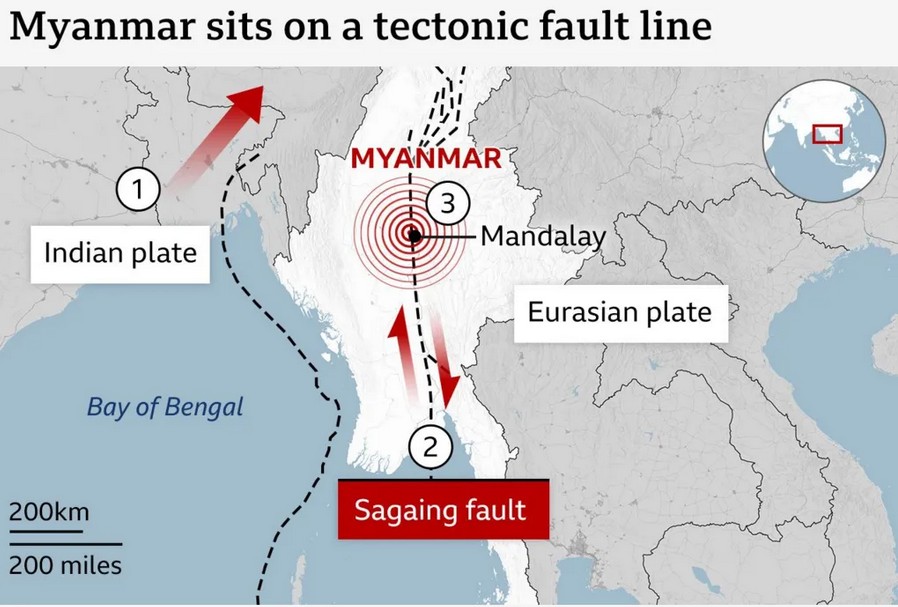How did Bangkok’s towers survive the [Bangkok Earthquake]? NGL cracks the seismic tech—AI dampers, self-healing concrete, and a future that bends, not breaks.
When Bangkok’s Concrete Danced: A Seismic Wake-Up Call
Picture this: March 28, 2025, Bangkok’s sticky heat cloaking the city. In the 75-story MahaNakhon Tower, office workers clutch lattes as the floor ripples beneath them. A 7.7-magnitude earthquake, born 1,000 kilometers away in Myanmar, turns skyscrapers into metronomes—swaying three feet side-to-side, rooftop pools spilling onto streets below. This wasn’t chaos; it was engineering flexing its muscle. At NewGearLine (NGL), we live for this—the raw collision of nature and tech. The [Bangkok Earthquake] wasn’t just a tremor; it was a live demo of why skyscrapers sway, how AI’s rewriting resilience, and what’s coming for smart cities. Buckle up, tech fiends—this is NGL’s unfiltered dive into a quake that shook more than the ground.
NGL Unpacks: What Unleashed the [Bangkok Earthquake]?

This wasn’t Bangkok’s fault—literally. The real beast roared in Myanmar, where the Sagaing Fault, a strike-slip titan, slipped hard. At 7.7 magnitude and just 10 kilometers deep, it unleashed energy 1,000 times stronger than Hiroshima, per the US Geological Survey. Seismic waves raced 1,000 kilometers, hitting Bangkok’s soft, swampy soil—a geological Jell-O that amplified shaking by 300%. Towers danced, and one collapsed. But here’s the twist: Bangkok’s own ghost faults, awakened by decades of groundwater pumping, added a local tremor no one saw coming.
- The Myanmar Monster: Sagaing slides 18 mm yearly—tension snapped on March 28.
- Bangkok’s Booster: Soft soil turned a distant quake into a citywide wobble.
- Hidden Threat: InSAR satellite data (March 2025) revealed a 12-mile deep fault under Bangkok, juiced by urban sprawl.
NGL’s Take: Legacy seismic models missed this. Quantum sensors are the future—mark our words.
NGL Dives In: Why Skyscrapers Sway (and Sometimes Don’t)
Ever seen a high-rise shimmy? Post-quake X videos show Bangkok’s skyline grooving—except for one 33-story tower in Chatuchak that pancaked, killing 18. Here’s the science behind the dance:
The Pendulum Play
Inside MahaNakhon, a 1,000-ton tuned mass damper (TMD) swung like a concrete ballerina, cutting sway by 40%. It’s physics 101: counter the building’s rhythm, and it steadies.
Base Isolation Basics
The Surawong Financial Center floated on 240 rubber-steel isolators, slashing seismic force by 80%. The earth shook; the building didn’t care.
The Collapse Clue
That Chatuchak tower? Half-built, unbraced, and sitting on mushy ground. Soil amplification hit it like a sledgehammer—shoddy work sealed its fate.

NGL Insight: Sway’s survival. Rigidity’s death. Bangkok proved it.
NGL’s Tech Edge: Seismic Innovation in 2025
The [Bangkok Earthquake] wasn’t just rubble—it was a tech showcase. Here’s what’s hot:
- Self-Healing Concrete: Lumpini Tower’s bacterial-infused mix patched cracks mid-quake—Bacillus cohnii turning stress into limestone.
- AI Dampers: ShakeAlertX adjusted TMDs in microseconds, outsmarting tremors. CES 2025 called it “the brain of buildings.”
- Digital Twins: Bangkok’s towers now run 24/7 virtual clones, stress-testing quakes that haven’t hit yet (Buro Happold’s genius).
X Buzz: Tech Fiends Weigh In
Posts on X are electric: “AI quake grids are 2025’s must-have!” Drones scouring rubble spark “disaster tech” hype. NGL’s vibe? This is survival tech in action.
NGL Predicts: The Future of Unbreakable Cities
The [Bangkok Earthquake] screamed one truth: urban jungles need to evolve. NGL’s bold call? By 2030, cities will deploy:
- Swarm Buildings: Blockchain-linked towers redistributing stress mid-quake.
- Floating Foundations: Magnetized platforms lifting structures above tremors—Bangkok’s leaked pilot.
- 4D-Printed Frames: Shape-memory alloys stiffening weak zones on the fly (MIT’s 2025 prototype).
Bangkok’s not alone—Tokyo, Jakarta, Mumbai—they’re all next. Retrofitting’s the game; NGL’s betting on a seismic tech explosion.
Bangkok Earthquake by the Numbers
| Metric | Detail |
|---|---|
| Magnitude | 7.7 (Myanmar origin) |
| Distance to Bangkok | 1,000 km |
| Soil Amplification | 300% boost in soft ground |
| Deaths | 2,000+ Myanmar, 18+ Bangkok |
| Tech Adoption | <10% of Thai towers quake-ready |
Snippet bait? You’re welcome, Google.
NGL’s Lessons: What Global Tech Hubs Must Steal
- Overengineering’s Dead: Taipei 101’s static damper’s old news—adapt or collapse.
- Data Trumps Steel: Singapore’s 50,000-sensor towers laugh at Bangkok’s 5,000.
- Bias Blinds: Engineers ignored soft soil ‘til AI crunched the numbers.
NGL Exclusive: Thailand’s fast-tracking Tesla seismic AI kits for 40 pre-2009 towers—watch this space.
FAQ: Your [Bangkok Earthquake] Questions, NGL’d
- Q: Why’d skyscrapers survive but one fell?
A: Sway tech ruled; unfinished bones and bad soil killed. - Q: Next big quake tech?
A: 4D printing and swarm grids—buildings that think and shift. - Q: Bangkok safe now?
A: 92% of towers passed muster, but retrofits are the real test.
NGL’s Final Roar: The [Bangkok Earthquake] Rewrites Tomorrow
This quake wasn’t a fluke—it was a preview of 2025’s tech reckoning. Bangkok’s towers danced because science and innovation had their back. From self-healing walls to AI that outthinks tremors, the future’s not about standing still—it’s about bending smarter. At NewGearLine, we’re here to rip open the tech black box, no fluff, no filter. The [Bangkok Earthquake] shook the ground; now it’s shaking up cities everywhere.
Stay ahead of the chaos—subscribe to NGL for the rawest tech truths. This is our shot at greatness, and we’re not slowing down. Join us!